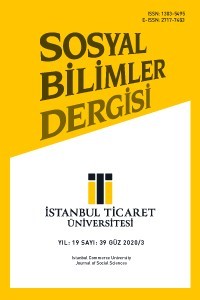SAĞLIKTA İNOVASYON PERFORMANSINI ÖLÇMEK İÇİN MODEL ÇERÇEVESİ ÖNERİSİ
Sağlıkta İnovasyon, Sağlıkta Dijital Dönüşüm, İnovasyon Yönetimi, İnovasyon Performans Ölçümü
Proposal Of A Model Framework For Measuring Innovation Performance In Health
Innovation in Health, Digital Transformation in Health, Innovation Management, Innovation Performance Measurement,
___
- Akçomak, S. İ., & Kalaycı, E. (2016). Ar-Ge ve yeniliğin ölçümü ve ar-ge ve yenilik anketi verilerinin araştırmada kullanılması. Retrieved from: http://www.stps.metu.edu.tr.
- Akgün, V. Ö., & Çini, M. A. (2021). Covid-19 pandemi sürecinde işletmelerin inovasyon kümesinin pazarlama ve yönetim perspektifinden değerlendirilmesi. Selçuk Üniversitesi Sosyal Bilimler Enstitüsü Dergisi, 45, 377–395. https://doi.org/10.52642/SUSBED.929910
- Anderson, F. (2003). The flow of innovative products from manufacturing industries to construction industries. Understanding Innovation in Canadian Industry, 367-384.
- Amato, S., & Lin Y. (2012). The decentralisation of health management systems through small and medıum enterprises in brıc-countries: A semantic model. Asian Academy of Management Journal Retrieved From: https://www.researchgate.net/publication/289180001
- Ayçin, E., & Çakın, E. (2019). Ülkelerin inovasyon performanslarının ölçümünde Entropi ve MABAC çok kriterli karar verme yöntemlerinin bütünleşik olarak kullanılması. Akdeniz İİBF Journal, 19(2), 326–351. https://doi.org/10.25294/AUIIBFD.649275
- Çırpan, H., & Güner, S. (2021). Kaotik durumlarda hastane yönetimi ve liderlik: Kovid-19 salgını üzerine nitel bir araştırma. Süleyman Demirel Üniversitesi Vizyoner Dergisi, 12(30), 449–465. https://doi.org/10.21076/vizyoner.820495
- Cravo Oliveira, T., Barrenho, E., Vernet Erkko Autio, A., & Barlow, J. (2017a). Developing a Global Healthcare Innovation Index. PIRU Publication 2017-20. Retrieved from: www.piru.ac.uk
- Daneshmand, A. N., & Bui, H. T. (2012). Innovation Measurement Software. Centre for Innovation, Research and Competence in the Learning Economy Lund University, Sweden. Retrieved from: download (lu.se)
- Darzi, Lord, & Parston, G. (2013). Global diffusion of healthcare innovation (GDHI). Retrieved from: https://www.wish.org.qa/reports/global-diffusion-of-healthcare-innovation-gdhi/
- Diederen, P., van Meijl, H., & Wolters, A. (2002). Innovation and Farm Performance: The Case of Dutch Agriculture. Innovation and Firm Performance. 73–85. https://doi.org/10.1057/9780230595880_4
- Elverdi, S. (2019). AR-GE tabanlı ekonomik büyüme sürecinde inovasyon unsurunun rolü: Uluslararası karşılaştırmalı bir analiz. Erciyes Üniversitesi, Kayseri. Retrieved from: https://tez.yok.gov.tr/UlusalTezMerkezi/tezSorguSonucYeni.jsp
- Innovation 360. (2021). Innovation management system. Retrieved from: https://innovation360.com/innovation-analytics/
- InnovationIQ. (2021). InnovationIQ Sertifikasyonu. Retrieved From: https://innovation-iq.org/innovationiq-certification/
- INSEAD. (2020). Global Innovation Index 2020. Retrieved From: https://www.globalinnovationindex.org/gii-2020-report#
- İstanbul Sanayi Odası. (2014). İstanbul Sanayi İnovasyon Endeksi. Retrieved From: https://www.iso.org.tr/projeler/inovasyon/istanbul-sanayi-inovasyon-endeksi/
- Karaata, E. S. (2012a). İnovasyonun ölçümünde yeni arayışlar. Retrieved From: https://ref.sabanciuniv.edu/sites/ref.sabanciuniv.edu/files/2021-04/skaraata_rapor_0.pdf
- Karaata, E. S. (2012b). Yenilik-yenileşim-iş dünyasına bir yolculuk. Retrieved From: https://www.egiad.org.tr/wp-content/uploads/arastirma-raporlari/inovasyon-raporu.pdf
- LeCompte, M. D., & Goetz, J. P. (1982). Problems of reliability and validity in ethnographic research. Rewiev of Educational Research, (52), 31–60.
- Mahroum, S., & Al-Saleh, Y. (2013). Towards a functional framework for measuring national innovation efficacy. Technovation, 33(10–11), 320–332. https://doi.org/10.1016/J.TECHNOVATION.2013.03.013
- NITI Aayog. (2020). India Innovation Index Report 2020. Retrieved from: https://www.drishtiias.com/daily-updates/daily-news-analysis/india-innovation-index-2020-niti-aayog
- Pefile, S., Li, Z., Ke, W., Guang, C., Chamas, C., & Bhojwani, H. (2005). Innovation in developing countries to meet health needs: Experiences of China, Brazil, South Africa, and India.
- Perker Cebeci, B., & Karaman Akgün, A. (2021). Covid-19’un inovasyon ve ihracat üzerine etkisi. Aksaray Üniversitesi İktisadi Ve İdari Bilimler Fakültesi Dergisi, 13(4), 83–96. https://doi.org/10.52791/aksarayiibd.947310
- Price WaterhouseCoopers. (2011). Medical Technology Innovation scorecard. The race for global leadership: Europe, the USA and Japan. Price WaterhouseCoopers, 1(5), 50. Retrieved from: https://www.pwc.com/il/en/pharmaceuticals/assets/innovation-scorecard.pdf
- Policy & Medicine (2018). PWC medical technology innovation scorecard: US falling behind in the race for global leadership. Retrieved from: https://www.policymed.com/2011/01/pwc-medical-technology- innovation-scorecard-us-falling-beind-in-the-race-for-global-leaderip.html
- İzmir Kalkınma Ajansı. (2016). İzmir yenilik göstergeleri ve yenilik ekosisteminin analizi 2016. Retrieved from: http://www.izka.org.tr/upload/Node/30332/files/yenilik_web.pdf World Intellectual Property Organization. (2021). Global innovation index 2021. Retrieved from: https://www.wipo.int/edocs/pubdocs/en/wipo_pub_gii_2021.pdf
- ISSN: 1303-5495
- Yayın Aralığı: Yılda 3 Sayı
- Başlangıç: 2002
- Yayıncı: İstanbul Ticaret Üniversitesi
ROBERT KOLEJİ’NİN BOĞAZİÇİ ÜNİVERSİTESİNE DEVRİ SÜRECİNDE YAŞANANLAR: 1960-1971
eTWINNING PROJE ÇALIŞMALARININ ÖĞRETMENLERİN BİRLİKTE ÇALIŞMA YETERLİLİKLERİNE ETKİSİ
FED FAİZ KARARLARININ ÜLKELER ÜZERİNDEKİ FİNANSAL ETKİLERİNİN İNCELENMESİ
ANNE BABAYA BAĞLANMA VE ERKEKSİ DAVRANIŞ ARASINDAKİ İLİŞKİNİN İNCELENMESİ
Rabia Şeyda AYDIN, Hakan SARIÇAM
TÜRKİYE EKONOMİSİNİN YAPISAL ÖZELLİKLERİNİN KOBİ’LERİN KÜRESEL REKABET GÜCÜNE ETKİLERİ
Mesut ŞENGÜLER, Muhittin ADIGÜZEL
Mevlüt CAMGÖZ, Sümeyye YILMAZTÜRK
Yorumlayıcı Fenomenolojik Analiz
ENTEGRE ENTROPİ-EDAS YAKLAŞIMIYLA LİDER TÜRK İHRACATÇILARININ PERFORMANS ANALİZİ
